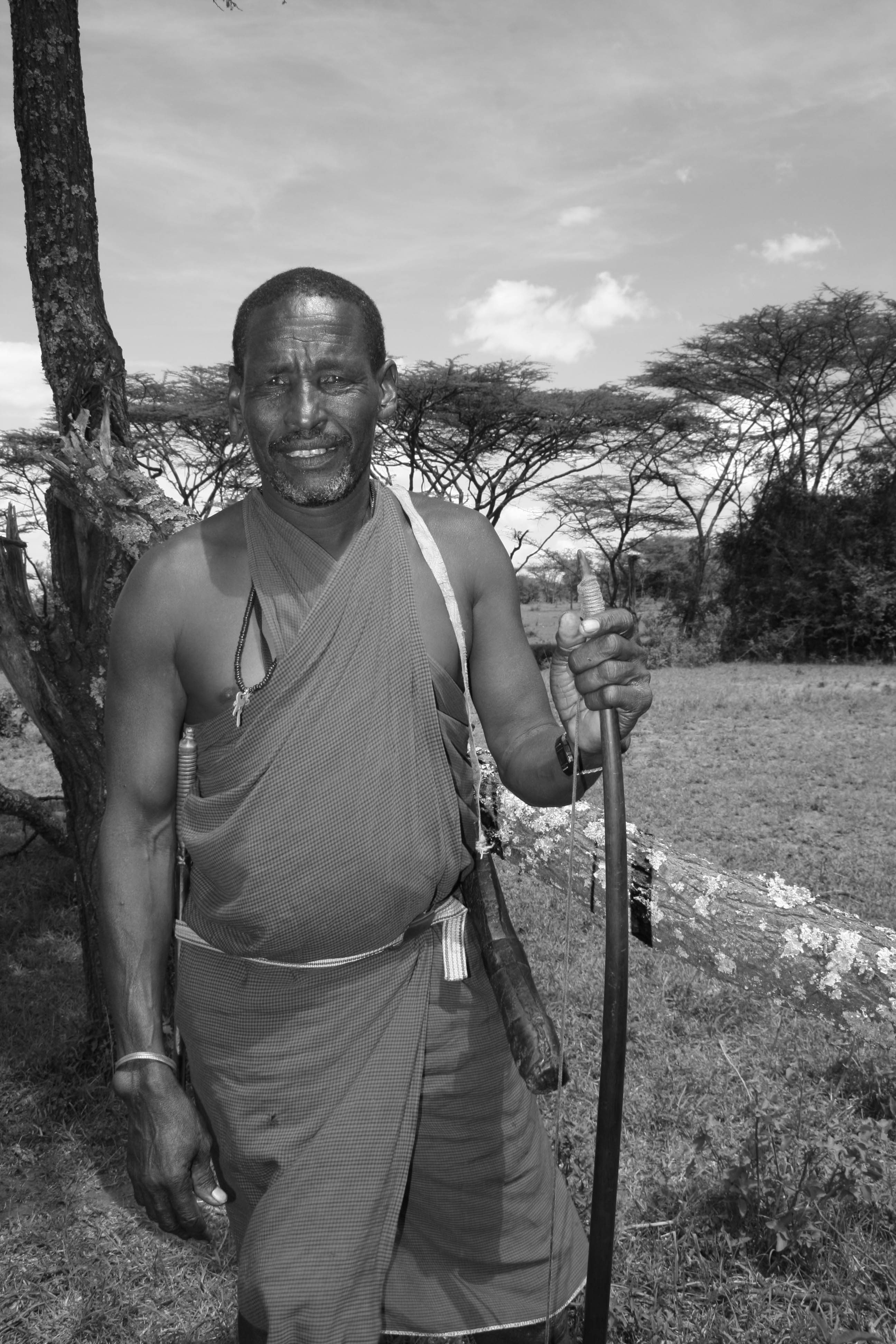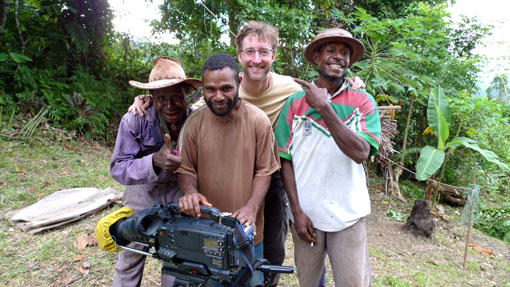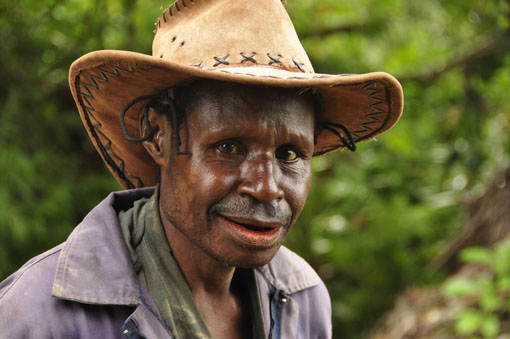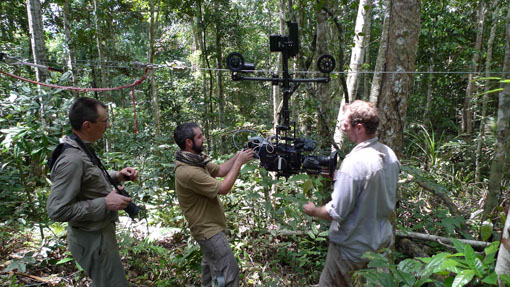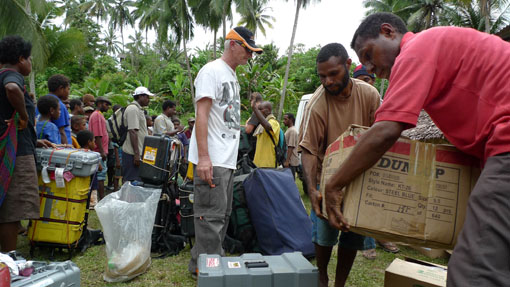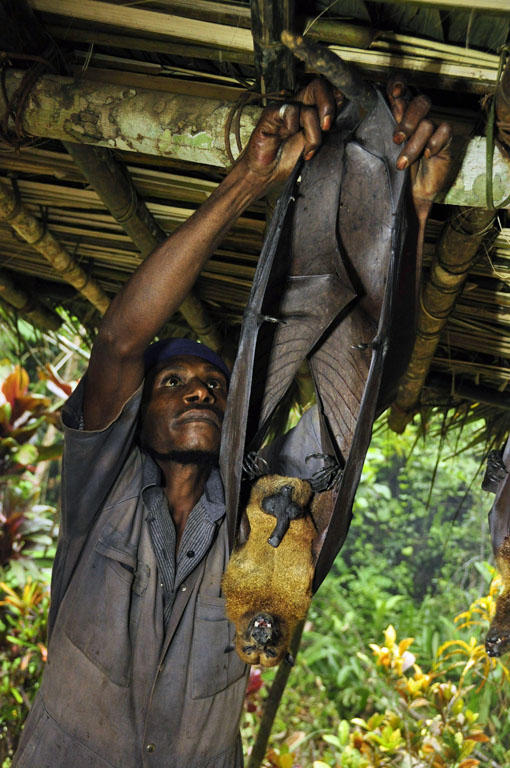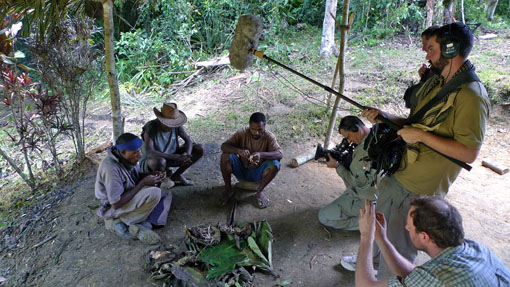Living with Lions
by Jane Atkins, Human Planet Researcher
‘You see, Lions and the Dorobo, we feed each other.’
‘If we hunt a large animal, we take away as much as we can, but leave the rest for the lions to feed on. And sometimes the lions kill a really fat animal and we say, lets take this one. It is not simple, you have to track carefully and quietly. You are scared.. thinking - will I be mauled?’
‘But when you are hungry and know lions have killed first - you take your chance. There are days when we eat only what the lion has killed. We live on those lion kills until we finally make our own kills.
When we filmed 3 Dorobo hunters stride up to 15 lions to steal from their fresh kill our hearts were in our mouths. Courageous? Ingenious? Suicidal? All of these perhaps, but this one act is undeniably impressive. The Dorobo say they are hunters just like lions. They watch lions, and how they hunt. Just as lions do, the Dorobo watch every animal on the great plains - and study each individual. Like lions they observe which ones are wounded, slower, easier to pick off. They wait and wait until the time is right to hunt. And if the lion gets there first, well the Dorobo turn that into another opportunity.

There are three lion prides living in the same area as the Dorobo. This 22 strong pride are just a few hundred metres from the Dorobo's regular camp.
But these opportunities are fading, and fast. These hunting and scavenging practices may be age old, but in 21st Century Kenya, they are banned under the country’s blanket law that no hunting is allowed in Kenya. Although the law was made primarily for big game hunters, it has been enforced at the local level, with traditional tribes, to avoid any ‘grey’ areas.
And so these Dorobo men are living a daily struggle of holding onto a lifestyle passed down through the generations; being free to walk through the great plains, hunt game to feed themselves and their family and sleep under the stars in caves and hidden valleys. Now, they all accept that although they were brought up to be hunters, they will not be bringing up their children to be hunters, to know the wildlife as intimately as they do.
Olkinyei is one of the last pockets in Kenya where the Dorobo still live, but in the last year, the area has been identified as a new conservancy, which means a step up in wildlife conservation in the area. This will ultimately push out of the Dorobo hunters.
And so in our lifetime, we will see an end to this ancient lifestyle of hunting, gathering and scavenging. An accumulative knowledge that has been passed down over 1000s of years.
In a time when stories about endangered wildlife regularly hit the headlines, few people seem to notice that incredible human cultures are being lost; ‘like swatting a mosquito - no-one seems to notice’. The irony here is that wildlife conservation has played a strong part in the Dorobo’s fate.
Whether you think this is right or wrong, it seems the fate for the Dorobo is inevitable. However, it may still be possible to keep their extraordinary tracking skills alive.
Today Jackson Looseyia, who runs a safari lodge in the Masaai Mara, has started employing Dorobo men to be spotters and trackers for his tourists. Jackson says, ‘If the Dorobo way of life disappears, so too does their knowledge. The Dorobo can spot and name any distant bird or animal, identify any nearby track or noise, and tell the story of hunt through reading the tracks in the sand.’
So perhaps this is one way for Rakita and his friends to keep their knowledge alive, even if their traditions die. It may not be as heart racing as hunting a buffalo, listening to the sounds of the night, or stealing food from a lion, but perhaps it’s enough? Rakita told me as we left ‘Of course I am sad to say goodbye to the life of my father, my grandfather… but what can I do? I cannot continue this life much more… I have already been in prison before now! And to bring up my son as a hunter here would be irresponsible. I don’t want him to go to prison. It is a shame, but what can I do?’.
If Human Planet achieves anything, a respectful salute to some of the people we filmed with would be a great thing. For the team back in the UK, finding some of these unique stories was hard, and filming them was challenging. But in a few years to come, these stories may turn out to be the last record of not just the Dorobo but many of the other people and cultures we were so privileged to film.
Watch the Dorobo steal from the lions here: http://www.youtube.com/watch?v=pNeNTMmltyc
Papua New Guinea - Wild Frontier
By Nicolas Brown, Producer/Director, Arctic and Mountains Team
Papua New Guinea has the feel of the Wild West. Because it’s a mountainous tropical island it doesn’t physically resemble a Spaghetti Western, but the larger than life characters and the ever-present threat of violence make it a frontier. This could be a set for Clint Eastwood- with a pierced nose.
As our small airplane nears its destination—Wewak town- we fly over the mighty Sepik River. Braided into a wide Delta of graceful interlocking ox bows, this is how rivers used to look hundreds of years ago. No channels or dams or bridges. The wildness is just a taste of what is around the corner.
On our descent, we are treated to a breathtaking overview. Wewak town is in the shadow of Mt. Turu, a 1600-metre high peak covered in dense jungle. But the real story—the one we have come to film—lies beneath the canopy, where literally hundreds of tribes make their living on the steep mountain slopes. My burning question is—exactly who have we come all this way to film?
In Papua New Guinea there are over 700 distinct tribes, in the East Sepik province (which is half the size of Ireland) there are 88 distinct languages spoken. Around this one single mountain- Mt. Turu- we counted 7 different ethnic groups. In terms of people, this place is wildly diverse.
This is the home of cannibalism and many say there are still tribes in the mountains that cannibalise each other. As recently the 1970s, four Dutch families were killed and eaten. Two years after that a priest and his 12 companions were killed.
Possibly more worrying for a BBC film crew, Wewak is famous for cargo cults. Prior to this trip, I had never heard of such a thing, but evidently during WWII the Japanese and Americans flew a lot of supplies—cargo- to the region. Once the war ended, the cargo stopped coming. In an attempt to get it back, local tribes evolved religious rituals that mimicked the activities of soldiers, such as wearing “headphones” made of wood and speaking into “radios” woven out of straw. You’d think they would have got tired of waiting for cargo by now, but evidently not.
When I suggested our original plan to fly to our location using helicopters, the image of us arriving from the sky with dozens of boxes of film equipment filled our local fixer with dread. “Are you crazy? You cannot come out of the sky carrying boxes of what looks like cargo—that would cause big trouble.” But, as we are about to find out, “big trouble” is coming anyway, in a different guise.
It starts on our first day. We had just loaded the vehicles with our filming equipment when the hotel owner enters and announces that a week ago, there was a jail-break in Port Moresby’ maximum security prison. Twelve of the most notorious criminals in PNG had escaped, including the most notorious of all—William Kapris. The hotel owner goes on to say that someone has just hijacked a 4×4 vehicle earlier this morning. Since William Kapris grew up near Wewak, the inference is that Kapris is back and is collecting 4x4s to escape into the mountains.
Two of the best 4×4 vehicles in town are ours- parked in front of the hotel, full of our gear. We debate our options. Some are suggesting that a BBC film crew would make a useful bargaining tool for a desperate criminal gang. Do we keep filming? Or do we hide in the hotel and watch the armed guards patrol the perimeter, while we put our feet up and drink beer? The decision falls to me.
I look at the sky which is moody and dark—this is the rainy season, and if we don’t leave now there’s a real chance that the roads will get so muddy that we will never reach our location. So I say, “let’s go filming, but keep our eyes and ears open.”
Of course, the minute we leave the hotel, everyone is a suspect. That man by the hedge—does he look like a mass murderer? That boy playing with his football against the wall—is he going to phone Kapris and tell him the 4x4s are on the way? On the road, the woman with her bag of vegetables—I imagine she is William’s sister who eventually liaises with the international hostage negotiators, saying “Don’t you think a BBC Producer’s life is worth a little more money than that? Pay up.”
Our visit to the local police is not encouraging. The Commander in Chief sees the BBC coming, and seizes a press opportunity. “Everything is under control—we have shoot to kill orders, and we are sure that we will find him and he will die.” I wanted to tell him, “We don’t care if you catch Kapris or not—we just don’t want us to be shot in some kind of crossfire confusion,” but I bit my lip.
We drive to our location without incident. At the village we are welcomed by the elders, and by our fascinating hero, Marcus. Marcus is a Yangoru Boiken hunter, but to the locals, he is a man feared for his magic powers.
To get our gear out to Marcus’ hunting grounds requires 40 some porters. So the whole village it seems comes under our employ. Our fixer AJ, who has done this before, makes a clear list of everyone’s names, and what we will pay them. And we set off.
On the way we are told never to stray from the path—not even to pee. Evidently, people from rival tribes will hide in the bushes, and then will leap out and stab you with a syringe filled with the poison of the giant centipedes that live here. Apparently it’s a very painful death.
Why someone would want to randomly murder you is not made clear. When I ask, the only answer that comes back is “witchcraft”. In the end I conclude that it is an effective way of controlling us—like telling children ghost stories so they don’t go wandering off at night.
We eventually film our sequence—which is a wonderful gothic tale that has never been filmed before. Marcus and his fellow hunters try to catch the giant fruit bats that fly over the canopy in the dead of night. How they catch them is ingenious and you can find out the whole story when you watch the mountains episode of Human Planet. 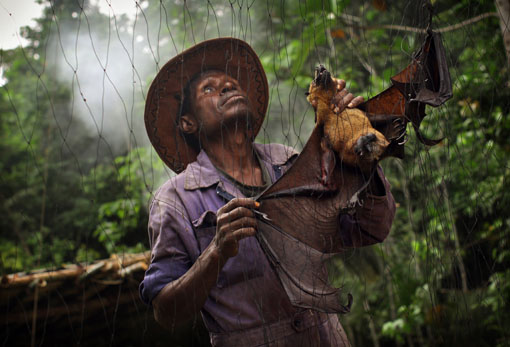
- Marcus capturing a bat in the net
We get to a point in the filming where we need to move locations to a different gap. It means a change in location, and a change in porters. So we are paying the porters and the trouble starts. Most people understand that in order to get paid, they need to have put their names on a list when they carried a load for us. But a few shifty looking men (who none of us had ever seen before) declare that they had worked for us but their names weren’t on the list. It gets heated. People are slamming fists, arguing with each other and with us. I can see the violence escalating.
So we decide to pay everyone double. And leave quickly. This puts a huge hole in our finances, but at least no-one has been hurt.
At our new location, there are more fees to be negotiated with the landowner. And we’re low on cash. But we make a deal, and begin filming. Then after about half a day, a man comes crashing through the jungle with a few henchmen wielding machetes. He declares that we are on his land, and he needs payment, or he will take action.
We explain that we have a deal in place with one person who owns the land. So who is this new guy? He says, “I am Joseph, tribal chief and the elder brother of the landowner.” Which makes Joseph a more senior landowner. And Joseph wasn’t informed about our project, which is against the tribal law. We immediately halt filming. We are back at the negotiating table.
Joseph has a remarkable command of legal sounding phrases, like “grievance” and “landowner rights”. And he wants money—a lot of it. And if we go home now, we can’t finish the film. Joseph seems to know this—he has a highly intuitive grasp of the art of blackmail.
Throughout the negotiations, I wryly note that Joseph’s younger brother—who we made a deal with in the first place—keeps schtum. He sees the possibility of more money coming his way, however indirectly. We are stuck, without enough cash to pay up, and with a half shot film.
Then, a few of our porters come over with a suggestion. They don’t like the blackmail that is going on, and they’ve never liked Joseph. He does this sort of thing all the time, and keeps all the money to himself. So they helpfully offer to get Joseph “drunk.”
“Oh that’s a nice gesture,” I say, “but it won’t really solve this predicament, will it?” They go on to explain that “getting someone drunk” is a euphemism for taking them into the woods and chopping them into bits with machetes. I can’t contain my horror—“Lord, no, don’t get him drunk! I don’t like the old codger, but that’s going way too far!”
In the end we compromise on a reduced fee for Joseph that pretty much ensures our “end of filming celebration” will be us drinking a round of tap water in the airport lounge. And Joseph is so pleased that he managed to squeeze more money from us that he invites a bunch of his friends to come watch us film. Every time he catches my eye, I wince, and it amuses him immensely. But we get the job done.
On our return journey I catch wind of a radio programme. It’s an English language call in show, and a voice speaks to the host. “This is William Kapris.” I am stunned by the meekness in his voice. To this day, I have no idea if this is a true story or just a prank, but the man claiming to be Kapris explains that the whole jail- break was organised by the government so that they could execute him on sight. It seems he knew some things about high-ranking officials that they didn’t want to come out in his trial. Now he’s on the run—maybe in Wewak—wanted dead or alive.
Like I said, Papua New Guinea is a bit of a frontier, and Wewak town belongs in the Wild West. Kapris is Jesse James. Joseph is Billy the Kid. And we are just a bunch of Westerners whose pockets were easily emptied.
Waiting for Kudu
by Tuppence Stone, Director/ Producer, Grasslands and Deserts team
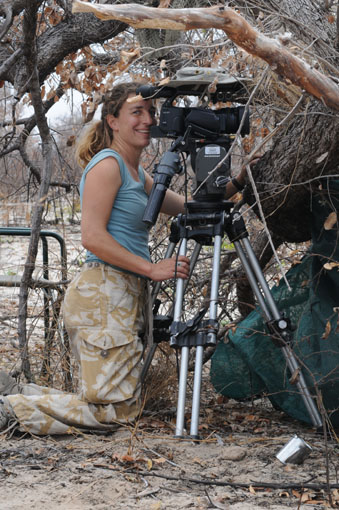
On location in Namibia
The enthusiasm of the first dawn was tangible. We rebuilt the grass hide, destroyed by elephants the night before, and I saw our cameraman Toby Strong plus camera and the two Bushmen hunters, Nao and Kun, creep inside. Their view of the waterhole was good and there were fresh kudu, oryx and ostrich tracks around. Arno, our guide, and I withdrew to observe as safety cover and I set up to film second camera – concentrating on the wildlife shoots, to complement Toby’s main action.
I spent hours crouched on a sloping grass-topped earth bank, craning my neck to see anything that might come into the waterhole without giving myself away. The sun was hot and I was shrouded by a camouflage string scarf which allowed me to see, but broke up my outline. Silence and stillness stretched through the hours. Parts of my body went to sleep, then pins and needles poked me alert again.
It is impossible to remain totally focused when there is precious little to focus on. I found my eyes wandering as I noticed the tiny action going on around my hiding place. Termites in their hundreds were crawling through the grass around me, nipping the stems into tiny lengths and posting it down the holes. Given long enough they would expose me..
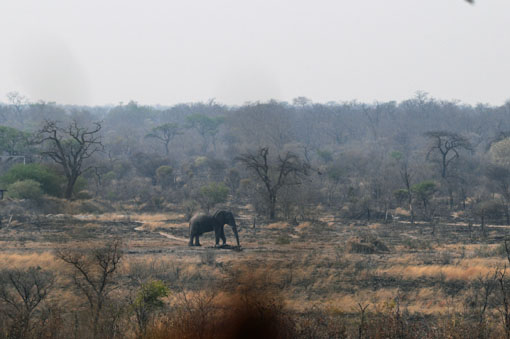
A bull elephant gets dangerously close to the hide (on the right)
It was great to have a role, but I knew I couldn’t jeopardise the crucial shot. If my actions spooked the wildlife, the hunters would not get a chance at their shot, then our story wouldn’t begin. Straining to see ostrich through the camouflage, I froze as they looked in my direction. The camera was recording, though it was above my head and the angle I had to twist to see the screen quickly became painful. I fought the aches, until the giant birds lumbered away.
The first day passed into sunset, without success. By Day Three the enthusiasm had passed, pessimism was rife and the wind had changed. The heat of the first day had been superseded by a blustery wind which carried our smell across the waterhole. This unseasonable weather was not what we needed. When the kudu approached they were edgy, and fewer came because the cooler air reduced their desire to drink.
Yet, slowly they came in, stepping, looking – again I froze. Again the mud bank crumbled under my inclined boots, again I strained to see the screen. With the bright light I couldn’t be sure they were in focus. I cursed and ever so slowly slipped my hand up under the scarf to adjust the camera. It’s tiring on the eyes to look through so many layers of focus: the weave of the scarf, the near grasses masking my face, then the middle distant brush and beyond that the approaching kudu. The concentration is intense. The kudu came closer. But then they stepped into the invisible zone where our smell tainted the air. They stamped, reeled round and were gone. No shot fired. No images today.
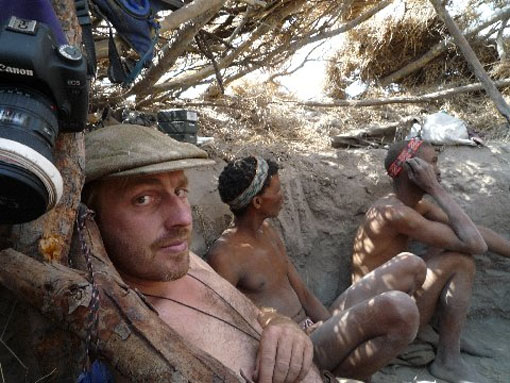
Toby, Nao and Kun in the hide
Day Three did bring a real surprise though. A leopard came into the waterhole at mid day, and it was intrigued by the hide. Slowly, slowly it approached the mound of grass, probably because it saw the potential of this cover as a good place to lie in wait. But the bushmen certainly didn’t want a leopard in the hide with them. Toby, sitting behind then, noticed their buttocks quivering alarmingly. As it wandered to within 20ft they lost their cool, shouted and crawled out of the hide to scare it - Kun pushed the younger Nao out in front of him, then clung to him as they saw off the predator. They didn’t seem such fearless hunters at that moment.
By Day Five we had changed our tactics. The wind had turned again, but the temperature remained low. The hunter’s hide was moved closer in and the morning doves in their hundreds didn’t mind the intrusion – but would the game be as relaxed? Arno and I had backed off further, initially to a distant hide and then the penthouse platform. So far from the action that binoculars were my only connection. But through them I willed the kudu into the waterhole. I was willing them to their death. Was it bloodthirsty, was I hard hearted? I cherish and respect wildlife, so shouldn’t I will the game to flee?
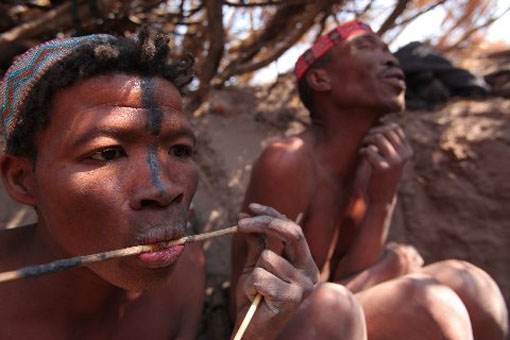
Nao softens the glue to repair an arrow Toby trod on
Though we had asked the bushmen to hunt in our time frame, the fact they were hunting was not unusual. If an animal was killed it would be because of us, yet if we were not there attempting to record the hunt, a different animal would have been taken by the hunters. Any kill is the only meat the bushmen families eat and a carcass provides a feast for the whole village as well as sinew for bow strings and twine, skins for bags and bone marrow to eat as well as knuckle bowls for preparing poison. What Nao and Kun were aiming to do was more honest than my weekly trip to the supermarket. Imagine how far our consumption of meat would go down if we had to sit for a week to catch that lamb or that cow, and then share it amongst our whole community!
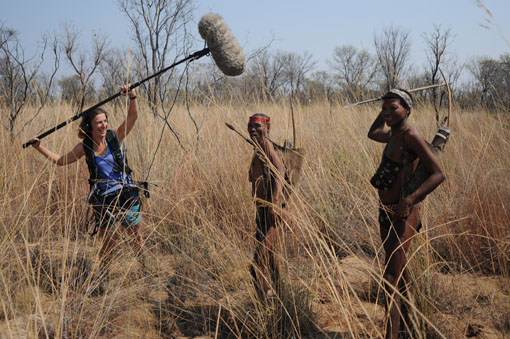
Capturing the sounds of the grasslands
Finally 2 male kudus with statuesque horns sauntered in. They came closer and the wind was kind.. The kudu were alert, frozen, staring at the hide for the longest time. This is your chance guys – do it! do it! I yelled in a whisper inside my head. But the males retreated, grazing close by for over an hour.
I could relax, stretch, move around because I was so far away, but I knew in the hide they would be frozen, silent, stealing glances, easing apart the grasses to make way for a shot. After what seemed like an eternity the males came closer again. Close enough to shoot surely. I saw the kudu react, turn, run, stop and look back. A shot had been fired, but missed. Our waiting continued.
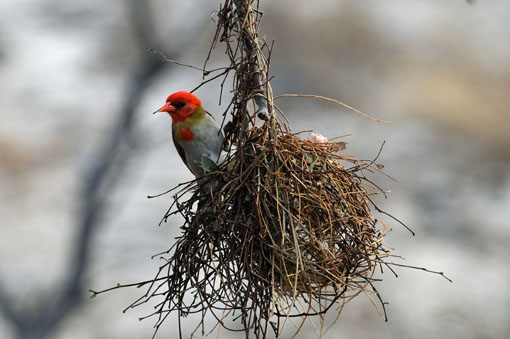
A red headed weaver bird in its 'hide' near our platform lookout
60 hours stretched to near 70 before another opportunity. A group of females were tentative, smelling and sensing something strange, but unsure quite what the nature of the danger was. A warthog ambled into the frame - likely to blow the hunter’s cover with its superior sense of smell. But instead of disaster, he was the perfect decoy. Drinking casually from the waterhole, he was oblivious to the hunters just feet away.
The kudu began to drink, the tension rose as I watched but could not influence events. Just as with the males, I saw them react and flee, but this time the walkie talkie crackled into life ‘It’s a hit, perhaps two’, said Toby, with real elation. The waiting was over.
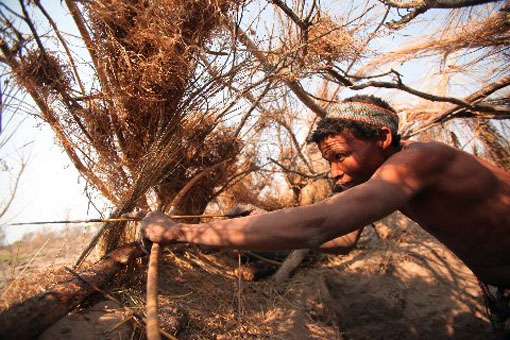
Nao takes aim
Nao had wounded his first kudu. His excitement was genuine and proud. But the hunt was still far from in the can. From here on we were no longer dependent on luck to bring the animals to us, but on the Bushmen’s skills as trackers to keep us on the trail. What we witnessed can be seen in the Grasslands programme, but needless to say – it didn’t go according to plan.
Land of the midnight sun
by Willow Murton, Assistant Producer, Arctic/Mountains team
“Wake up Willow!” shouts a voice.
I pull off my eye mask and open my eyes. The sun shines bright above me. I look at my watch. Three o’clock in the morning? I sit bolt upright, lifting my head from the make do pillow. Reindeer hair sticks to my cheek. Simon the sound recordist mutters as he rigidly stares out ahead of us. Beth the researcher alongside us is, like me, struggling with sleep deprivation and the daylight. I am still trying to focus my eyes in the dazzling night of the Arctic summer. Suddenly I see the figures along the ice edge. Five men, spread out along the horizon, all poised, waiting…watching for their target.
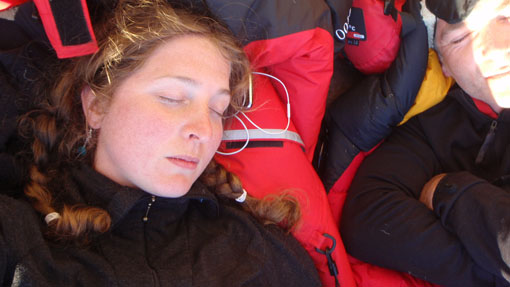
Simon (Forrester) and I just before our sudden awakening
Simon swears. We aren’t hunters but we know the rules. We mustn’t do anything, we mustn’t move, cannot move from our dogsled bed. I spot our tripod and camera, no cameraman anywhere nearby. I am filled with a dreadful nauseous realisation – this could be the moment that we have spent over a year working towards. Months of careful negotiations and awkward logistics all for us to sleep through our only possible chance of filming a narwhal hunt. We can only sit and watch in confused disbelief… At that moment, the silhouette of a whale crests the ice edge. I wonder how on earth I am going to explain this to the team back in Cardiff…
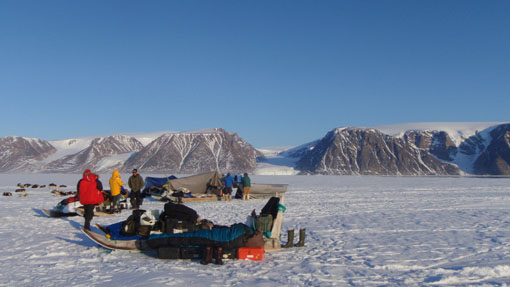
Our camp
Surreal scenes like this are surely what you are supposed to wake from rather than wake up to. It’s late Spring in Northern Greenland , there is no reference to time as the sun never sets so the days blend into each other. In the full glare of the midnight sun this is a place where anything seems possible and where dreaming and being seem to meet.
The landscape itself is constantly changing as the sea ice melts and the winds reshape it continually. One morning it is a distant horizon and the next it reappears broken against the floe edge like shattered glass. Weeks of watching ice charts are no preparation for what life on the ice demands. We are four hours from the town of Qaanaaq and a world away from the scientific maps of metereology. The brothers we are filming read the ice because they have learnt that their lives depend on it.
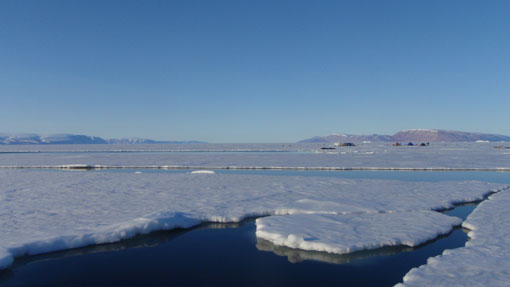
Our camp in the distance beside the melting ice edge
Our camp of six sleds is set on a floating platform of ice, around five metres thick. We must always be ready to move in case the ice cracks and we find ourselves adrift in the freezing Arctic Ocean. All the hunters have a warning tale to tell. We live between the anxiety of the hunt and the ice watch and the monotony of no day and night and the constant of rehydrated food rations. We put sun cream on at two in the morning and wear sunglasses in our sleeping bags. We laugh with the hunters, with each other, to ourselves. We develop our own ways of dealing with the daylight and the long hours of nervous despair waiting for invisible whales to return.
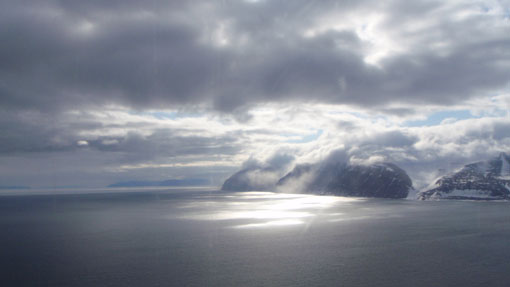
A surreal, ever-changing landscape
What happened next after that first daylit night on the ice edge, only the film can tell. Finally coming back to the predictable shades of the British summer was itself like awakening from a distant dream.
Dale Templar - Series Producer
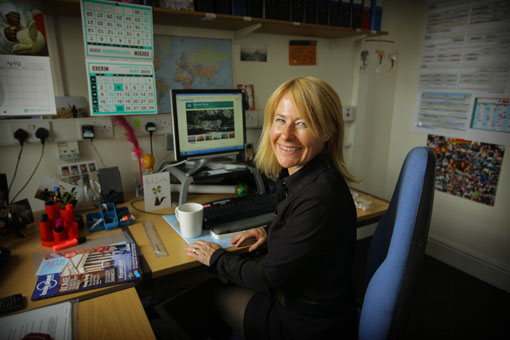
I think I have already moaned about the British Summer in an earlier blog, and believe me it’s easy to moan. Reading Willow’s account of summer life in Greenland does make we remember how lucky we are here in the UK. Living with 24 hour sunlight is really strange and does mess with your head and sleep patterns. I was lucky enough to spend time in Antarctica filming penguins - the cameraman and I had to wait until 3.30am to film the sunset! The flip side however is far worse; there are many communities in the Arctic as well as the scientists down South, who have to spend months of the year in total darkness. That would totally do my head in! I would suffer from SAD (Sunlight Affective Disorder) and seriously go mad!
I was talking this week to a producer from Glasgow. Apparently SAD is a real problem there and the Scottish Government is considering handing out vitamin D to people because of the lack of sunlight in the winter months. So, can you imagine what it must be like in Greenland? Anyway, I’m looking forward to viewing footage from central Africa next week. Now there’s a great place to be, 12 hours of darkness and 12 hours of sunshine, the perfect mix for film makers.



